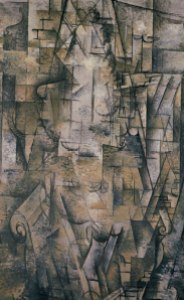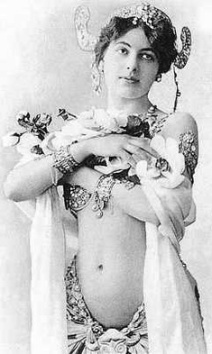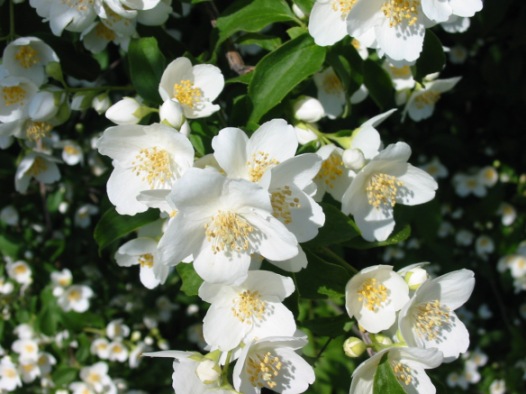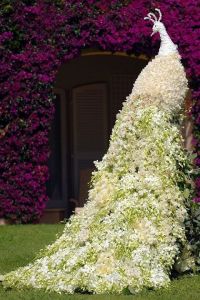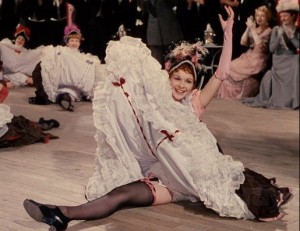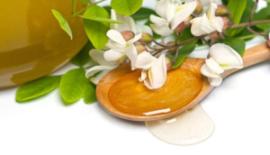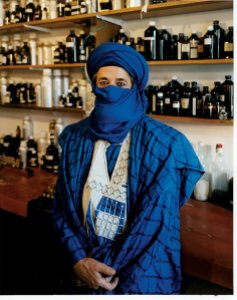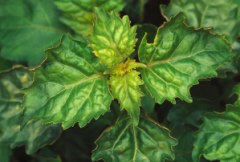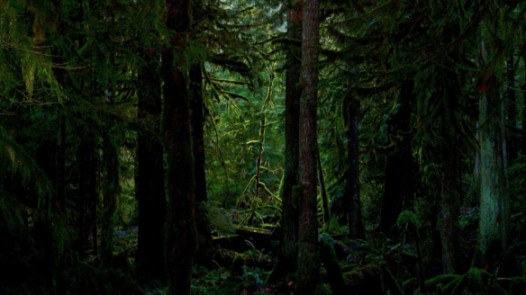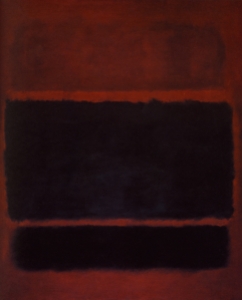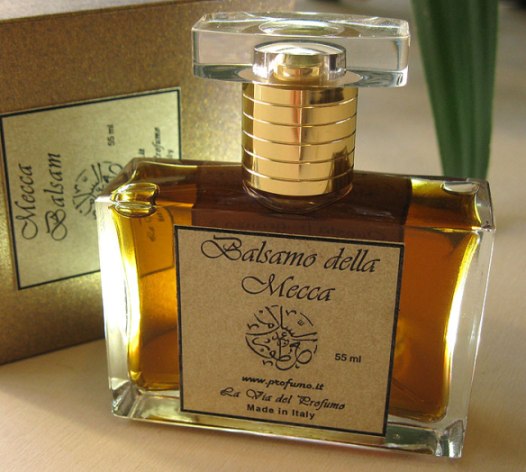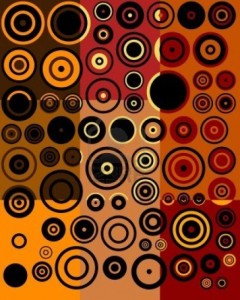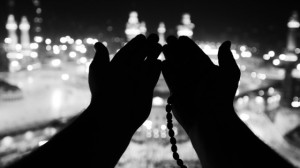Close your eyes, and imagine yourself on the side of a mountain. It is one in a range of craggy giants on the Hindu Kush, each one stonier and more barren than the last. You stand on a narrow ledge beside large boulders, breath in the cold air, and survey a vast no-man’s land that is a vista of grey and brown, dotted with the green of pine trees. You wonder from whence comes the strong smell of cold, dusty incense that the wind wraps around you. You see no-one, feeling like the last man on earth as the dust at your feet intermingles with the crushed needles of pine trees. The austerity feels holy and serene, as if you were at the top of Mother Nature’s craggiest cathedral, and you turn inward before you drift off in a blur of myrrh and pine.
That emotional, meditative, and visual trip is the essential aroma of Hindu Kush, as well as its explicit goal and inspiration. Hindu Kush is the creation of Dominique Dubrana, who also goes by the name “AbdesSalaam Attar.” His perfume house, La Via del Profumo, focuses on all-natural fragrances, many of which have a Middle Eastern flair or subtext. Abdes Salaam Attar’s description of Hindu Kush on his Profumo website is useful because I think it really conveys a lot about the fragrance’s feel or emotional spirit, particularly the first part about the mountains:
The chain of mountains of the Hindu Kush is the natural boundary of the ancient India with Persia and central Asia. It is from here that the sacred river Indus comes down from the highest valleys with unbridled force. [¶] It’s a rough and wild land difficult to get to and populated by fierce warriors who challenge every day the intrusion of progress. This is a land the time forgot where neither people nor landscapes are contaminated by technology. Here travellers can fall in love with the air that they breathe and with the state of mind that overcomes someone until they become part of the mountain and part of the people changing clothes, habits and religion.
The unforgettable fragrance of the Hindu Kush is made of the aroma of its forests, of its wood fires and the smells of the bazaars overflowing with oriental spices and things to eat.
Hindu Kush is the perfume that unites both the sacred and the profane. The aromas of incenses and perfumed woods are woven together with those of the sensual and appetising fragrances of oriental spices. […] Close your eyes and breathe in, Hindu Kush is like taking a walk in an Indian market, where clouds of incense smoke escape through the open doors of temples to be mixed with the perfumes of the east, ginger, cumin, nutmeg and pepper. [¶] Take a step inside and all is peace, silence and meditation, take a step outside and you find the crowd rushing here and there, noises and confusion.
For these reasons Hindu Kush is a perfume for people who feel attracted by eastern mystics, in which the sacred and the profane become confused in the everyday life, and for many people simply to smell it is an emotional experience because it generates the state of mind they are inwardly looking for.
Hindu Kush is not loved by everybody, this should teach us to be humble and make us reflect that harmony between physical and inner realities is not an aim in itself but is merely a mean to reach a much higher goal.
As best as I can determine, the list of notes seems to be:
Incense, perfumed or aromatic woods, ginger, cumin, nutmeg, pepper.
I have mentioned a few times that I am a hedonist, and I am undoubtedly a heathen as well, because I’m not particularly one for mysticism of any kind. Things like spiritual exercises, meditation, and enlightenment leave this sybarite feeling rather bewildered and lost. I’m all about decadent excess and hot sensuality, which is perhaps one reason why I struggled with the cool austerity of Hindu Kush.
The more specific reason is that myrrh is a troublesome note for me, and I need to make that clear at the outset. I love incense, when it is frankincense. Myrrh, however, is difficult for me with its cool, dusty, stony, white, and, often, soapy qualities. And Hindu Kush is a largely myrrh-centered fragrance. It never evokes the usual Catholic “High Church” feeling that most olibanum fragrances do, but it does evoke Nature’s church set in piney, barren, stony, and dusty mountains. I think Hindu Kush accomplishes its express goal beautifully, and there is no doubt that it is a high-quality, brilliantly made fragrance. I deeply respect it, but it lies far outside my personal comfort zone because of the olibanum focus. You need to keep that in mind as I describe it.
Hindu Kush opens on my skin with myrrh’s cold, dusty, white smoke, followed by an intense, pungent green that feels like galbanum with hints of moss. Then, the warm, nutty, highly honeyed touch of sweet myrrh (opoponax) arrives, followed by the aroma of old wood. The latter is fascinating as it is dry, crumbly, honeyed, dusty, but also like sweet wood all at once. In short, it’s like the most unusual, cool but warm, saw dust. I’ve never encountered a note quite like in perfumery, and it’s brilliantly original.
There is a distinct pine aroma that becomes stronger and stronger with the passing minutes. It smells like Pine Sap Absolute, with a very honeyed, ambered tonality. It reminds me of a much smoother, softer version of the souped-up, tarry pine sap in Profumum Roma‘s Arso. This version is nowhere as sweet, let alone as coniferous, tarry or phenolic. Instead, it is dry, dusted by old woods, and infused by the stony coolness of the myrrh.
As the pine sap grows stronger, that pungent blast of green from the galbanum-like note in the opening fades away and its place is taken by an amorphous, muted, indistinct touch of spices. I’ve worn Hindu Kush a few times, and only in one of my tests was there a really powerful, distinct, clearly delineated aroma of ginger. It smells like the powdered, dry kind that you have in your pantry, not the more spicy, piquant aroma that you get from fresh ginger. In any event, most of the time, the spices are quite abstract on my skin, vaguely feeling like the peppered, dusty, combined aroma you find in a spice shop where all the odors blend into one gentle mass. The spice accord is a very subtle one, lingering on the sidelines to add a bit of depth to the woody-incense duality that dominates Hindu Kush’s main core.
Ten minutes in, Hindu Kush is a truly original, unusual blend of aromas. It reminds me simultaneously of: an old church set mostly outdoors in a pine forest clearing dusted by dry lichen mosses and filled with the aroma of myrrh incense; a carpenter’s workshop filled with dry, sweet sawdust; and the arid, dry, mountain range of a country I once lived in, where the cool winds and great heights created a solemn sparsity and austere serenity. I keep using the word “fascinating,” because it really is, but I’m not sure it’s very me.
Hindu Kush starts to shift around the 20 minute mark. The sweet myrrh’s honeyed beeswax rises to the surface to soften and dilute the cold, dusty dryness of the myrrh’s incense. Hindu Kush is now a blend of cool white smoke, warm honeyed beeswax, amorphous spices, dry woods, and a touch of pine resin. The pungent, galbanum-like note has completely vanished, and the only green touches left are that from the yellow-green pine resin. Deep down in the base, there is a nebulous floral note that flits about, popping up once in a blue moon from behind the two types of myrrh, then quickly fading away once again. I can’t place it, and it keeps vanishing whenever I try to pinpoint it, but it’s a very brief breath of delicate, warm floracy.
On my skin, and in repeated tests, Hindu Kush is primarily a tale of two myrrhs: sweet and regular. They are nestled in a dry-sweet woody embrace that becomes increasingly amorphous, with only the pine sap really standing out. The spices briefly add a soft, dusty pepperiness to the top notes, but slowly lose ground less than 40 minutes in. The most noticeable thing about Hindu Kush are the contrasts: cool versus warm; sweet versus dry; dusty versus honeyed wax; and old wood shavings versus fresh, yellowed, pine sap. From start to finish, it’s a visual palette of greys, whites, taupe, and honeyed cream, with a splash of dark, pine green tossed about like something from the painter, Jackson Pollack. Actually, Pollack’s signature is of hectic frenzy and chaos — two things that most definitely are not a part of Hindu Kush — so a more accurate comparison would be to the cragginess of George Braque’s “Woman Reading” from 1911.
The greatest changes in Hindu Kush pertain to the sillage, and to the degree of the honeyed sweet myrrh. 30 minutes in, the sillage drops, and the fragrance hovers 2 inches above the skin. After 90 minutes, the sillage softens even further, and Hindu Kush lies right above the skin. In all cases, however, it is potent and rich when smelled up close. As a whole, it is primarily a blend of myrrh with piney resin and the merest hint of sweet myrrh. It is cold, a bit dusty, and very austere. In a few tests, there was a touch of soapiness at this point, but it was very minor on my skin. The pine resin has lost its sweet aspects, and feels more like the concentrated oil from crushed pine needles. It adds yet another level of coolness to Hindu Kush.
Images of a carpenter’s workshop have vanished, along with that of any church (set in nature or otherwise), or a spice store. I’m now fully atop a craggy, jagged, dusty mountain with only pine trees and their detritus around me, and the cold wind blowing olibanum my way. I would prefer more of the sweet myrrh to try to counter some of this austerity, because the creamy smoothness of the honeyed beeswax is my favorite part. Unfortunately, the note really fluctuates on my skin during the first four hours. Half the time, it hides behind the cool, stony myrrh, but occasionally it is just as noticeable and Hindu Kush turns into a triptych of myrrh, sweet myrrh, and pine sap resin.
Hindu Kush remains that way until its very end. It takes 3 hours for Hindu Kush to turn into a skin scent, though it is only hard to detect after the 4th hour. All in all, it consistently lasted between 7 and 8 hours on my skin depending on the quantity that I used. A small amount, approximately 3 small smears, gave me the lower time frame, while 3 big sprays gave me more. The sillage throughout was very discreet after the third or fourth hour, depending on the quantity that I applied.
Hindu Kush has received extremely positive reviews on Basenotes‘ official listing for the scent (where it is also listed as “Indu Kush”). I think the description from a poster called “Quarry” really sums up one aspect of it very well:
My notion of new-sawn wood is vastly different from yours, I’m sure. I expect your experiences harken from freshly cut trees or home-improvement-center lumber or year-old firewood. Whereas the most impressionable wood from my life is much older, as are the buildings and furnishings that make up our home. Even as my dear husband renovates our house, he’s using lumber harvested generations ago and stored through most of the 1900s by my frugal father. The green vapors have dissipated from this stuff; it is tightly grained, resin-sweet, and musty-dusty in a good way. To my mind, this kind of wood is the primary ingredient in Hindu Kush. Its creator talks of “taking a walk in an Indian market, where clouds of incense smoke escape through the open doors of temples to be mixed with the perfumes of the east, ginger, cumin, nutmeg and pepper.” Not having any experiences like that, I associate HK’s secondary accord to be like walking past the open door of a Penzeys Spices store–there’s just that general melange of comforting scents–not firey, not sharp. And this, my friends, is the totality of Hindu Kush: simplicity, beauty, timelessness, and without gender. Unlike any other of the hundreds of bottled fragrances I’ve smelled, I want to draw in HK’s scent deeply, like you would steam from a pungent soup or narcotic smoke. It feels like you should breath Hindu Kush, and I suppose at least part of that is due to its being composed of natural ingredients.
When I first sampled HK from a bottle with a reducer opening, I thought the scent faded away too quickly, but once I applied it from an atomizer and allowed the overspray to hit my cuffs, I was rewarded with hours and hours of aroma. Now, having gotten to know the scent over many days, I can find only one drawback to wearing it: I am too contented. Where other fragrances may make me kick up my heals or swoon or smile, Hindu Kush will let me settle and feel lazy, wistful. So it isn’t a workday fragrance–at least not a workday where you actually want to get anything accomplished.
All six of the other Basenotes reviews are positive, though they describe a scent that is more incense-driven than woody. A few examples from both men and women:
- Quarry has written an absolutely fabulous commentary on Hindu Kush! For me, I get the initial blast of green – almost camphorous – which disappears almost as mysteriously as it came…yet somehow, it leaves a residual green that combines with dry woods and incense. […] it feels like the dry & cozy warmth of a small cabin whose only source of heat is a woodburner! I find this association quite charming. […] My personal preferences don’t usually run in the direction of incense based fragrances, but I find myself intrigued and impressed!
- “Hindu Kush” is one of the most aptly named perfumes I have ever come across. It smells exactly like the Hindu Kush-mountains look like: Very sparse, stony, airy and cold, with some woods underneath the mountains. I can even smell the wind blowing! There is just a little coziness in it, like sitting by a small campfire and trying to catch at least a little bit of warmth. Together with the somewhat mysterious “Mecca Balsam” is this my favourite perfume that I have sampled from the “Scents of the Soul”-line. Whereas “Mecca Balsam” is warm, uplifting and inviting, an indoor kind of smell, “Hindu Kush” is more grounded, rough and cold, an outdoor kind of smell, and I must admit that it’s not always easy to wear ’cause it’s so austere. Although the both perfumes are totally different, they share a certain quality that is able to put me in a meditative state of mind. Awesome stuff!
- Hindu Kush is an appealing spicy Oriental fragrance and an all-natural frankincense perfume that anyone who likes incense ought to love. It starts with a conglomoration of exotic spices, both pungent and sweet, each appearing quickly at different intervals. The incense is high-quality and rich. At the base is a thick, deep labdanum–a dark amber–smelling of wood and, in combination with the spices, a bit smoky with subtle, maple nuances. Altogether, it creates a mystical, adventurous, rather sexy fragrance.
- Soothing, spiritual and uplifting. [¶] My favorite fragrances have resinous woods and incense, and I’m loving this. 5 stars, full bottle worthy. [¶][…] wearing this is: an experience. It’s the kind of scent I reach for when I’m in meditative or contemplative mood, or for when I want to feel calm and grounded. I have a little collection of calming resinous scents and this so far is my favorite go to of the bunch.
- Funny how I could smell the deep green mossy undertones within minutes of application. Beyond the aromatic spices and uplifting incense, HINDU KUSH shows surprising depth, with beguiling balsamic facets that put me in a meditative, even contemplative mood. Luca Turin hit the nail on the head when he described it as ‘resinous oakmoss’.
Speaking of Luca Turin, La Via del Profumo are the only all-natural fragrances that he has reviewed and covered in his Perfumes: The A-Z Guide. Mr. Turin is on record saying that Dominique Dubrana is the only all-natural perfumer that he will bother with, because otherwise he will get “hideous crap.” His full quote to The New York Times:
There are dozens of all-natural perfumers; I don’t pay much attention to them, because every time I do I get a bunch of hideous crap. But I love his fragrances. I don’t think anyone can touch him in the field of natural perfumery.
Luca Turin has included three of Mr. Dubrana’s scents in his Perfumes book, awarding each Four Stars. The review for Hindu Kush is succinct and to the point:
If your favorite part of Mitsouko is the resinous, floor-wax-and-church-incense start, here it is in the pure state, made with only natural materials and delicious, though not particularly long-lasting.
I’ve noticed that Profumo scents do better in terms of longevity when sprayed, rather than dabbed. One of the Basenotes commentators thought the same for Hindu Kush. That said, as an all-natural fragrance, you have to keep in mind that the longevity won’t be as great as for regular perfumes which have synthetic additives included often for the sole task of increasing a scent’s duration.
I enjoyed testing Hindu Kush, and absolutely loved the unique, visual and mental trip of being transported to that austere mountain range. Alas, I am a heathen with no spirituality, and little long-term appreciation for myrrh. I don’t own a single fragrance centered around the note, because it isn’t something I personally could wear on a regular basis. That doesn’t mean I don’t respect Hindu Kush, though. I do, and I think it’s a masterful, brilliantly original take on an incense fragrance. So, if you’re a fan of myrrh, then you should give Hindu Kush a sniff. It is wholly unisex in nature, and suitable for the office with its discreet sillage. More importantly, it is an experience. From top to bottom, it a mood scent with an extremely meditative, contemplative feel to it. Smell it, and take a trip to the Hindu Kush in all its stark, resinous, serene beauty.
Disclosure: My sample was courtesy of AbdesSalaam Attar. That did not impact this review. I do not do paid reviews, my views are my own, and my first obligation is honesty to my readers.









